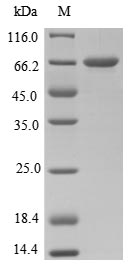Recombinant Clostridium tetani Tetanus toxin (tetX) gets produced in E. coli and includes an N-terminal 6xHis-B2M tag that makes purification and detection more straightforward. This partial protein covers amino acids 2-457 and shows purity levels exceeding 85%, as confirmed through SDS-PAGE analysis. The product is designed strictly for research purposes and appears to provide a reliable source of tetanus toxin for different experimental work.
Clostridium tetani produces the naturally occurring tetanus toxin, which is recognized for its powerful neurotoxic properties that disrupt normal muscle contractions. It has become important in neurological research because of how it blocks neurotransmitter release at synapses, ultimately causing muscle paralysis. Getting a better grasp of its mechanism may be key for creating strategies to combat its effects and enhance therapeutic approaches.
Potential Applications
Note: The applications listed below are based on what we know about this protein's biological functions, published research, and experience from experts in the field. However, we haven't fully tested all of these applications ourselves yet. We'd recommend running some preliminary tests first to make sure they work for your specific research goals.
Clostridium tetani Tetanus toxin is a complex neurotoxin that requires precise folding, proper disulfide bond formation, proteolytic cleavage into heavy and light chains, and specific tertiary structure for its functional activity in neuronal binding and toxicity. The E. coli expression system cannot provide the necessary folding environment for this large bacterial toxin, including correct disulfide bonding or proteolytic processing. The N-terminal 6xHis-B2M tag is large (B2M is ~12 kDa) and may sterically interfere with the protein's folding and functional domains. The partial fragment (2-457aa) represents only a portion of the full-length toxin (1315aa) and lacks critical domains required for toxicity, such as the complete binding and catalytic regions. Therefore, the probability of correct folding with bioactivity is extremely low without experimental validation.
1. Antibody Development and Characterization
This application has significant limitations. Antibody development relies on antigenic epitopes, but the partial fragment with a large foreign tag may not present conformational epitopes found in the native toxin. Antibodies generated may primarily target the tag or linear sequences, and might not efficiently recognize the full-length, properly folded tetanus toxin. If correctly folded (verified), it could be suitable for linear epitope recognition; if misfolded (unverified), antibody specificity may be poor and not applicable to native toxin studies.
2. Biochemical and Structural Analysis
Basic biochemical and biophysical characterization can be performed, but results will not reflect the native toxin's structure. Techniques like circular dichroism or mass spectrometry can assess the fragment's properties, but the lack of full-length context, potential misfolding, and large tag mean data may be irrelevant to the native protein. If correctly folded (verified), limited insights may be gained; if misfolded (unverified), characterization describes an artificial construct.
Final Recommendation & Action Plan
This recombinant tetanus toxin fragment expressed in E. coli with a large B2M tag is unsuitable for functional studies due to the essential requirements for proper folding, disulfide bonding, and proteolytic processing that cannot be met in this system. Application 1 (antibody development) can proceed with severe limitations. Interaction studies and functional studies should be avoided entirely due to the high risk of artefacts. Application 2 (biochemical characterization) provides only basic insights into the recombinant fragment, not the native toxin. For reliable tetanus toxin research, use full-length or correctly processed fragments expressed in eukaryotic systems or native toxin preparations, with rigorous functional validation.






